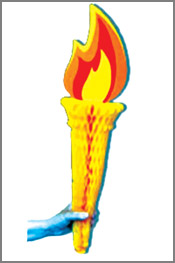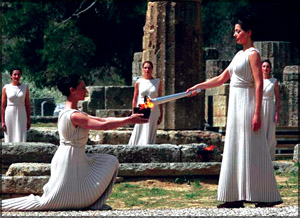The Olympic Torch - a legendary tradition
The heat of the 2008 Olympics is on! The excitement that has been
stirred up in China is gradually spreading throughout the world.
The key event that has contributed to arouse this excitement is the
Olympic Torch Relay, which is a tradition that has come down the ages as
an integral part of the Olympics, both Winter and Summer. Let’s look at
this fascinating tradition in today’s edition.
The Story Behind the Tradition
 Fire is a power which helped man to cook his food, keep him warm, and
get rid of the darkness. According to Greek mythology, fire has been
discovered because the god Prometheus stole fire from Zeus and gave it
to humans. Fire is a power which helped man to cook his food, keep him warm, and
get rid of the darkness. According to Greek mythology, fire has been
discovered because the god Prometheus stole fire from Zeus and gave it
to humans.
This has been celebrated by Greeks by having relay races where the
athletes passed a lit torch to one another until the winner reached the
finish line.
The first Olympic Games can be tracked back to 776 B.C. where the
event was held once in every four years to honour Zeus and other Greek
gods.
The period of the Olympics was spent as a period of peace, and during
this time the runners known as ‘heralds of peace’ used to travel
throughout Greece declaring a truce to all wars, and the truce remained
throughout the Olympics in order to make the event a success and provide
safe passage to spectators.
The combination of these two occurrences can be considered as the
root of the modern Olympic torch relay.
The Birth of the Modern Torch Relay
The first Olympic Torch Relay was held at the 1936 Berlin Summer
Games as a result of steps taken by Carl Diem, a German history
professor and Secretary General of the Organizing Committee of the
Games.
 This was done with the intention of connecting the Olympics to the
traditions of ancient Olympics. This first Olympic Torch Relay had the
flame lit in Olympia, Greece, just like it had been done centuries
before, and then carried to Berlin, for the start of the Olympics. This was done with the intention of connecting the Olympics to the
traditions of ancient Olympics. This first Olympic Torch Relay had the
flame lit in Olympia, Greece, just like it had been done centuries
before, and then carried to Berlin, for the start of the Olympics.
The tradition continues and the flame is still lit at the Temple of
Hera in Olympia, Greece, as it had been done centuries ago. The Olympic
torch is lit several months before the start of the actual Games in the
same way it was done back then.
A priestess used to light the torch in ancient days. Therefore, it is
simulated(reproduced or acted out) nowadays too, by having an actress
dressed as a ceremonial priestess, in the robes of the ancient Greeks,
to light the torch using the same technique used in the original Games.
This uses a parabolic mirror and due to the mirror’s curved shape,
when it is held towards the Sun, the curvature focuses the rays to a
single point which has a high degree of heat. The priestess holds the
torch at this particular point, and the heat ignites (causes to burn)
the fuel in the torch, sparking a flame.
The Modern Olympic Torch
The torch itself is not just a stick with a fire burning on one end.
Careful thought has been given to the design, safety, tolerance to
adverse weather conditions and many other aspects.
The designing of the torch for the Olympics is pretty serious and the
look of the modern Olympic torch originated with John Hench, a Disney
artist who designed the torch for the 1960 Winter Olympics in Squaw
Valley, California.
All the torches that were made after that were based on this design.
Since then, designers have tried to make the torch a more aesthetic and
unique item which represents the host country and the theme for that
Olympic Games.
A torch can take a year or two to be designed and built, and for one
Game, even around 15,000 torches can be made since all the runners
throughout the relay use one torch each. Each runner has the opportunity
to acquire his torch at the end of his lap of the relay.
Some Amazing Relays
 Ever since the tradition of the torch was initiated, there have been
some amazing relay and modes of transport of the torch, although the
length of each relay itself is overwhelming. Ever since the tradition of the torch was initiated, there have been
some amazing relay and modes of transport of the torch, although the
length of each relay itself is overwhelming.
Though the torch is generally carried by runners, it has been
transported by boat in 1948 to cross the English Channel, and the
aeroplane was the transportation mode in 1952, when the torch travelled
to Helsinki.
The way that the flame was transported in 1976 has been really
exciting, since the flame was transformed to a radio signal for the
first time. From Athens, this signal was carried by satellite to Canada,
where it was received and used to start a laser beam to re-light the
flame in Canada.
The torch relay of the 2004 Olympics was also special since it was
the first ever global torch relay where the Olympic flame covered a
distance of more than 78,000 km in the hands of some 11,300 torchbearers
over a duration of 78 days. This relay had visited all previous Olympic
cities before returning to Athens.
The torch relay of 2008 is also significant since it is scheduled to
reach Mount Everest as well.
- Aravinda Dassanayake
|
